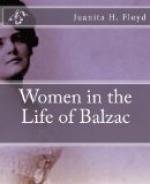In 1842, Balzac dedicated La Maison-du-Chat-qui-pelote to Mademoiselle Marie de Montbeau, the daughter of Camille Delannoy, a friend of his sister, and the granddaughter of Madame Delannoy.
Another friend of Balzac’s family was Madame de Pommereul. In the fall of 1828 after his serious financial loss, Balzac went to visit Baron and Madame de Pommereul in Brittany, where he obtained the material for Les Chouans, and became familiar with the chateau de Fougere. To please Madame de Pommereul, Balzac changed the name of his book from Le Gars to Les Chouans, after temporarily calling it Le Dernier Chouan.
She has given a beautiful pen portrait of the youthful Balzac in which she describes minutely his appearance, noting his beautiful hands, his intelligent forehead and his expressive golden brown eyes. There was something in his manner of speaking, in his gestures, in his general appearance, so much goodness, confidence, naivete and frankness that it was impossible to know him without loving him, and his exuberant good nature was infectious. In spite of his misfortunes, he had not been in their company a quarter of an hour, and they had not even shown him to his room, before he had brought the general and herself to tears with laughter.
“On some evenings he remained in the drawing-room in company with his hosts, and entered into controversies with Madame de Pommereul, who, being very pious herself, tried to persuade him to make a practice of religion; while Balzac, in return, when the discussion was exhausted, endeavored to teach her the rules of backgammon. But the one remained unconverted and the other never mastered the course of the noble game. Occasionally he helped to pass the time by inventing stories, which he told with all the vividness of which he was master.”
A few months after this prolonged visit, Balzac wrote to General de Pommereul, expressing his deep appreciation of their hospitality, and in speaking of the book which he had just written, hoped that Madame de Pommereul would laugh at some details about the butter, the weddings, the stiles, and the difficulties of going to the ball, etc., which he had inserted in his work,—if she could read it without falling asleep.
Balzac made perhaps his most prolonged visits in the home of another old family friend, M. de Margonne, who was living with his wife at Sache. He describes his life there thus:
“Sache is the remains of a castle on the Indre, in one of the most delicious valleys of Touraine. The proprietor, a man of fifty-five, used to dandle me on his knee. He has a pious and intolerant wife, rather deformed and not clever. I go there for him; and besides, I am free there. They accept me throughout the region as a child; I have no value whatever, and I am happy to be there, like a monk in a monastery. I always go there to meditate serious works. The sky there is




